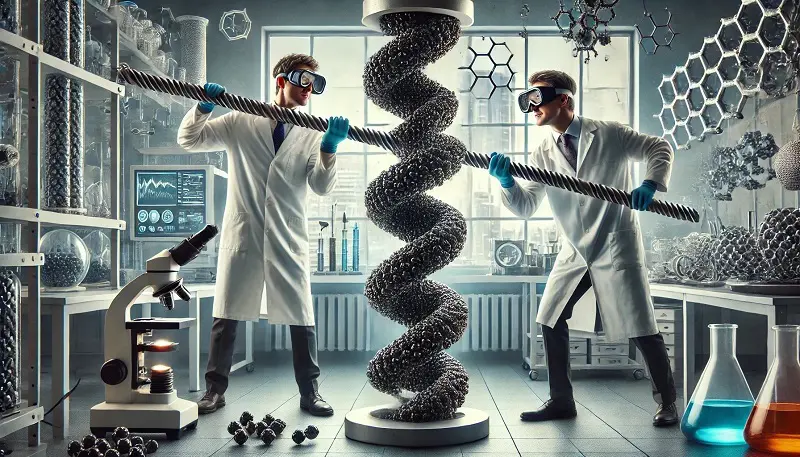A team of 20 team global scientists have published research findings showing that “twisted single-walled carbon nanotube ropes” can store three times more energy per unit mass than advanced lithium-ion batteries.
The Search For New Energy Sources
The research team, which includes members from the University of Maryland- Baltimore County (UMBC) and its Centre for Advanced Sensor Technology (CAST) set out to look at new energy sources to help meet the net-zero objective needed by the next-generation. As the researchers noted: “Energy acquisition in itself is not enough, and an environmentally compatible approach for efficient energy storage during times of high demand is presently the top-ranking priority for humankind.”
Twisted Carbon Nanotubes
The researchers discovered that a twisted rope composed of single-walled carbon nanotubes (SWCNTs) “possesses the remarkable ability to reversibly store nanomechanical energy”. In fact, these ropes (wrapped in thermoplastic polyurethane elastomers) were found to be able to store over 10,000 times more energy than steel springs and three times more energy than the best lithium-ion batteries.
Also, unlike chemical and electrochemical energy carriers, the nanomechanical energy stored in a SWCNT rope was found to be very safe, even in harsh conditions, with the energy not depleting over time and remaining accessible in a wide temperature range (from −60 to +100°C).
In addition to being able to store vast amounts of energy, SWCNTs are 100 times stronger and five times stiffer than steel at a fraction of its weight, with unparalleled mechanical toughness. They are also easy to manufacture!
Applications
With the SWCNT rope samples investigated in the research being “miniscule”, the researchers have suggested their current use could be for microscale energy storage in hydro and wind power and in small devices. However, advances in SWCNT spinning could make them suitable for other applications, but further research would be required, e.g. to make ropes with greater energy storage.
That said, with their high energy storage capacity, safety, and stability across a wide temperature range, it’s possible that SWCNTs could be used in future to power things such as medical devices and implants safely within the human body. They could also conceivably be used to enhance wearable electronics, support sensors in harsh environments, and perhaps be used in advanced space technologies. It’s understood that one of the first uses of the twisted carbon nanotubes is as an energy source for a prototype sensor that the CAST team is developing.
Exciting Discovery
Although energy has been stored in mechanical coil springs to power devices such as watches and toys for many years, the SWCNTs developed by the researchers have dramatically increased the amount of energy that can be stored in a tiny, coiled structure.
For this reason, Sanjeev Kumar Ujjain, from CAST, a lead researcher on the work, said: “This research shows twisted carbon nanotubes have great potential for mechanical energy storage, and we are excited to share the news with the world.”
What Does This Mean For Your Business?
The breakthrough in twisted single-walled carbon nanotube (SWCNT) ropes presents a transformative opportunity for businesses across various sectors. The ability of SWCNT ropes to store three times more energy per unit mass than advanced lithium-ion batteries and 10,000 times more than steel springs signifies a substantial leap in energy storage technology. This innovation offers a pathway to more efficient and sustainable energy solutions, aligning with global net-zero objectives.
For companies involved in renewable energy, SWCNT ropes could revolutionise microscale energy storage, particularly in hydro and wind power applications. Their high energy-density and stability across a wide temperature range ensure consistent performance and safety, even in harsh environments. This makes them a reliable option for remote or extreme condition deployments, enhancing the resilience and efficiency of renewable energy systems.
In the healthcare sector, the application of SWCNT ropes in powering medical devices and implants opens up new possibilities. Their compact size and high energy capacity make them ideal for long-lasting, safe energy storage in medical technologies, potentially improving patient outcomes and reducing the need for frequent interventions.
The electronics industry can also benefit from the integration of SWCNT ropes into wearable devices. Their lightweight and flexible nature, coupled with significant energy storage capabilities, can lead to the development of more advanced, longer-lasting wearable technology, enhancing user experience and device functionality.
Also, the aerospace and defence industries could leverage the unparalleled mechanical toughness and energy density of SWCNT ropes for powering sensors and other critical components in space and military technologies. The ability to maintain performance across a broad temperature range further suggests their suitability for such demanding applications.
The discovery of twisted carbon nanotube ropes, therefore, represents a significant advancement in energy storage technology, offering numerous applications across various industries. Businesses that invest in this technology early on could gain a competitive edge by developing innovative, energy-efficient products and solutions that meet the growing demand for sustainable and reliable energy sources.


